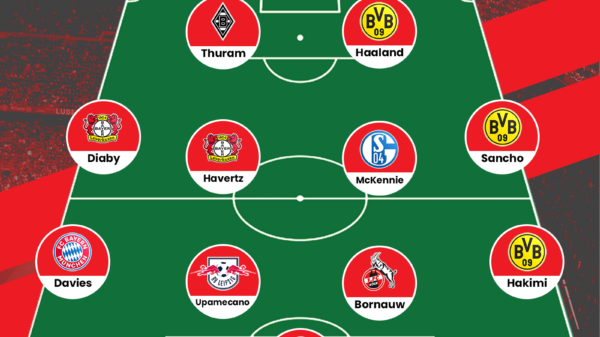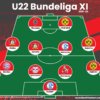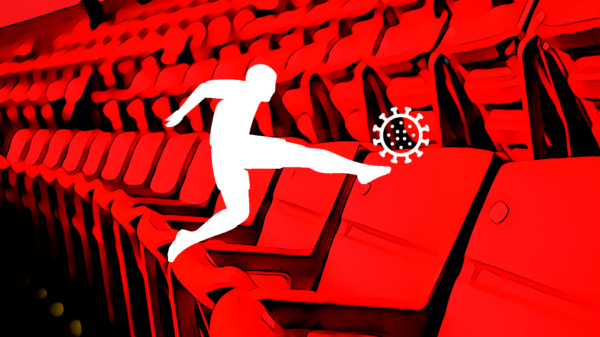Bayern Munich came into this game unbeaten in 12 games and a comfortable 12 points lead over 2nd place Borussia Dortmund. They would have been buoyed by the fact that Dortmund dropped points earlier in the day against Hamburg.
Schalke have been struggling to get back into the Champions League spots this season but they are still dreaming of a good run in current season’s competition.
Bayern
Bayern started off with their customary 4-2-3-1 formation. Holger Badstuber, and Xherdan Shaqiri had to sit out due to injury. Mario Gomez got a rare start up front ahead of the in form Croat, Mario Mandzukic.
Bayern have been absolutely dominant this season, scoring 55 goals, and conceding only 7 over the 21 games played in the season thus far, and they showed no sign of changing this in the game against Schalke. The Bavarian outfit went about their job in ruthless fashion and showed no mercy at all.
Firstly, their metronome passing was a joy to behold. Due to the fact that their wingers wreak havoc in opposing defences, the midfielders like Martinez and Schweinsteiger get time and space, and can focus on creating chances and distribution rather than defensive duties. This leads to dominance in midfield and a constant stream of chances coming the way of their forwards.
Despite the fact that the central duo does not have to defend much, they do so impressively when they are required to (especially Martinez who clocked up 7 interceptions).
Apart from the midfield dominance, the preferred mode of attack for ‘Die Roten’ is from the wings. With 2 world-class wide men and 2 world-class full backs, the German giants can cause problems to almost any defence from the wide areas. The overlapping runs and combination play, especially between Ribery and David Alaba are a joy to behold. What makes it even more brutal is the pace at which they play, making it far too difficult for defenders to deal with them. German international Benedikt Howedes had a torrid time dealing with Ribery.
Due to their attacking prowess, Bayern face a lot of teams who simply set up to defend against them, and keep them out. The large numbers in defence are generally a problem that is not easily dealt with, but Bayern employ dribbles to good effect. There is a conscious effort on the part of their players to use their skill and pace to take on opponents in a bid to create space. Bayern Munich completed an impressive 11 dribbles out of 23 attempts in the game against Schalke, with most such successful dribbles occurring in the wide areas.
What has definitely aided Bayern in their quest to create space to break teams down is the movement of Toni Kroos. The young German is given a free role, and utilizes this freedom very well. His movement off the ball in particular is vital in creating space for his teammates. A good example is how he dragged opposing midfielders, especially Neustatder, the player who was supposed to lend protection to the Schalke back 4, around. He constantly drops deep, or wide to receive the ball and create the little triangles in which Bayern pass the ball, and his passes are accurate as well and creative in nature. All in all, his presence is a major factor in determining the penetrative ability of Bayern’s passes.
Throughout this season, Bayern have pounded their opponents into submission by constantly applying pressure. They’re able to do this because they win the ball back very quickly. In order to do so, they press in groups, and basically surround a player so he has no option other than to play a loose pass or kick the ball out of play. Such smothering often does the trick, and can frustrate the opposition, along with work on their mental stamina.
A key change that trainer Jupp Heynckes has made this season is the constant movement. The fluidity of their play has definitely improved and this not only improves penetration, but also aids ball retention. A number of occasions saw Bayern players exchanging positions, or playing ‘out of position’. This sort of movement makes attackers hard to mark.
Still more evidence of the ability of this side lies in their execution of set pieces. The fantastic corner kicks, from the likes of Kroos, and the accurate free kicks create a lot of chances for them. Their second goal of the night came from a direct free kick conversion by Bastian Schweinsteiger.
The incoming coach, Pep Guardiola is going to face a tough task improving the performances of this team, and it will a great achievement for him to keep them even at their current level.
Schalke
Going into the game, Schalke were not looking good, because a number of their key players were suffering from injuries and suspensions. Star striker Huntelaar was declared unfit on Thursday after he burst a blood vessel in his eye. However, a number of Schalke fans made the long trip to Bavaria to watch their team, and they must be credited for that.
Schalke started the game with a 4-1-4-1 formation. This was designed to allow them to play on the counter, with Pukki designated to hold up the ball and try to utilize the pace of wingers like Michel Bastos. However, this plan didn’t work out too well for Schalke as they hardly managed to get on the ball.
In defence, they held their shape well, and used 2 banks of 4 with the defensive midfielder, Neustadter, given the duty of protecting the vital area in front of the defence. The wide players, Barnetta and Bastos were supposed to track back and work in tandem with the full backs in order to provide protection on the wings, an areas were Bayern tend to thrive due to their excellent wingers, and attacking full backs.
Over the course of the game, Bayern enjoyed 63% of ball possession, meaning that Schalke hardly got a chance to influence proceedings. In the first half, Schalke were able to complete only 82 passes (75% completion rate) as opposed to 320 by Bayern Munich. This was because their players were closed down so quickly. The second half saw a marginal improvement, where Schalke improved their pass completion rate to 80%, and managed to complete 143 passes. This was because they upped their tempo. Due to the fact that Bayern were closing down so rapidly in the first half, the Schalke players struggled to find space. In order to create this space, they moved the ball faster, making it harder for the Bayern players to keep up with the ball and surround a player effectively and cut off his options efficiently.
Schalke’s main aim was to counter through the pace of their wingers, by having them run into the space created by Lahm and Alaba when the Bayern duo ventured forward. This didn’t work out very well as Bastos wasted the opportunities he got, and had a poor game overall, and Barnetta looked woefully out of form, and completely clueless going forward. The miserable performance Schalke put up (comments on BayMun’s defence in a bit) resulted in a grand total of 0 shots on target over the 90 minutes, and only 2.18% of the game was spent in Bayern’s final third.
Graphs via Squawka.com, tactical illustration made at footballtactics.net
- Analysis: Are Chelsea’s pressing issues a concern? - October 5, 2020
- Has Financial Fair Play Been Worth It? - August 27, 2020
- Tactical Philosophy: Frank Lampard - May 20, 2020




























































